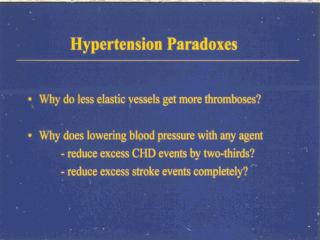 |
If we accept that the hypertensive subject at highest risk is
the one with the highest pulse pressure, or the stiffest vessel, this provides a couple of
related paradoxes. Firstly, why should less elastic vessels develop more thrombotic
events? And secondly, why should it be that lowering blood pressure can reverse a large
part, if not all, this excess risk within two to three years of initiating treatment?
Moreover, this reduction in risk appears to be similar regardless of the type of
anti-hypertensive agent used, and therefore mechanism of action. |
